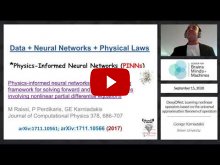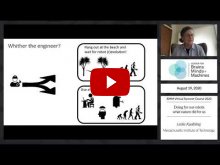
Recorded:
Sep 15, 2020
Uploaded:
September 16, 2020
Part of
All Captioned Videos, Brains, Minds and Machines Seminar Series
Speaker(s):
George Karniadakis, Brown University
It is widely known that neural networks (NNs) are universal approximators of continuous functions, however, a less known but powerful result is that a NN with a single hidden layer can approximate accurately any nonlinear continuous operator. This...

Recorded:
Sep 3, 2020
Uploaded:
September 4, 2020
Part of
All Captioned Videos, Computational Tutorials
CBMM Speaker(s):
Maddie Pelz
Lookit is an online platform for designing and running asynchronous developmental studies. This technology allows for more diverse and representative populations to participate in developmental studies than would typically be able to engage in the...

Recorded:
Aug 21, 2020
Uploaded:
August 21, 2020
Part of
All Captioned Videos, Brains, Minds and Machines Summer Course 2020

Recorded:
Aug 21, 2020
Uploaded:
August 21, 2020
Part of
All Captioned Videos, Brains, Minds and Machines Summer Course 2020
CBMM Speaker(s):
Josh McDermott

Recorded:
Aug 21, 2020
Uploaded:
August 21, 2020
Part of
All Captioned Videos, Brains, Minds and Machines Summer Course 2020
CBMM Speaker(s):
Lorenzo Rosasco

Recorded:
Aug 20, 2020
Uploaded:
August 21, 2020
Part of
All Captioned Videos, Brains, Minds and Machines Summer Course 2020
CBMM Speaker(s):
Georgios Evangelopoulos, Leyla Isik, Bill Lotter, Gemma Roig, Andrea Tacchetti, Hanlin Tang
Speaker(s):
Yibiao Zhao

Recorded:
Aug 20, 2020
Uploaded:
August 21, 2020
Part of
All Captioned Videos, Brains, Minds and Machines Summer Course 2020
CBMM Speaker(s):
Matt Wilson

Recorded:
Aug 19, 2020
Uploaded:
August 20, 2020
Part of
All Captioned Videos, Brains, Minds and Machines Summer Course 2020
CBMM Speaker(s):
Mengmi Zhang

Recorded:
Aug 19, 2020
Uploaded:
August 20, 2020
Part of
All Captioned Videos, Brains, Minds and Machines Summer Course 2020
Speaker(s):
Stefanie Tellex, Brown University

Recorded:
Aug 19, 2020
Uploaded:
August 20, 2020
Part of
All Captioned Videos, Brains, Minds and Machines Summer Course 2020
CBMM Speaker(s):
Leslie P. Kaelbling










